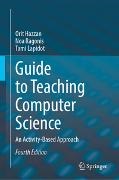Share
Fr. 116.00
Orit Hazzan, Tami Lapidot, Noa Ragonis
Guide to Teaching Computer Science - An Activity-Based Approach
English · Hardback
New edition in preparation, currently unavailable
Description
Focusing on the teaching of computer science in the generative A.I. (GenAI) era, the 4th edition of this Guide to Teaching Computer Science aims to contribute to the urgent effort to rethink and redesign computer science education.
This Guide to Teaching Computer Science is intended for all computer science educators, from elementary, middle and high school to academia. It is organized in a way that enables an immediate application of its main ideas. This goal is achieved by presenting the rationale for addressing a variety of computer science education topics, as well as their detailed actual teaching process (including activities, worksheets, topics for discussions, and more). The rise of GenAI necessitates immediate changes in computer science education, even as we recognize that predictions about the future of the discipline of computer science—and of educational systems more broadly—must be made with caution.
- The guide focuses on computer science education – teaching and learning.
- The guide is organized in three parts: Overview of Contemporary Computer Science Education; Computer Science Education Pedagogy: Research and Implementation; and Teacher Preparation Frameworks.
- Each chapter presents a pedagogical topic along with its meaning, importance and relevance in the context of computer science education, its basic pedagogical principles, and how it can be applied in computer science education in general—and in the Methods of Teaching Computer Science (MTCS) course in particular.
- Topics addressed in this guide include the following in the context of computer science education: research in computer science education; learners’ alternative conceptions; types of questions; assessment; teaching methods and learning spaces; lab-based teaching; teaching planning; teacher preparation programs; and prospective teachers practicum.
List of contents
Introduction—What Is this Guide About?.- Active Learning and the Active-Learning-Based Teaching Model.- Overview of the Discipline of Computer Science.- Computational Thinking.- Computer Science Soft Concepts and Soft Skills.- Data Science and Computer Science Education.- Research in Computer Science Education.- Problem-Solving Strategies.- Learners’ Alternative Conceptions.- Teaching Methods in Computer Science Education.- Lab-Based Teaching.- Types of Questions in Computer Science Education.- Assessment.- Teaching Planning.- Design of Methods of Teaching Computer Science Courses.- Getting Experience in Computer Science Education.- High School Computer Science Teacher Preparation Programs.- Epilogue.About the author
Dr. Orit Hazzan is Professor at the Department of Education in Science and Technology at Technion – Israel Institute of Technology. Her other publications include the Springer titles Application of Management Theories for STEM Education, Risk Management of Education Systems, The MERge Model for Business Development, Agile Anywhere, and Agile Software Engineering.
Dr. Noa Ragonis is a researcher in the field of computer science education, focusing on cognitive aspects of teaching and learning, particularly in relation to logic programming, object oriented programming, and computational thinking. She has authored ten computer science high-school textbooks and teachers' guides.
Dr. Tami Lapidot is Executive Manager of Machshava – the Israeli National Center for Computer Science Teachers.
All three authors have extensive experience of teaching, management, research, and involvement in computer science teacher preparation programs, as well as of participation in national initiatives and policy-making committees. They have taught courses on computer science and on computer science education to high school pupils, undergraduate students, and pre-service and in-service teachers. The research the authors have conducted examines a variety of computer science education topics, including teaching methods, learning processes, teacher preparation, and social and organizational issues of computer science education.
Summary
This concise yet thorough textbook presents an active-learning model for the teaching of computer science. Offering both a conceptual framework and detailed implementation guidelines, the work is designed to support a Methods of Teaching Computer Science (MTCS) course, but may be applied to the teaching of any area of computer science at any level, from elementary school to university. This text is not limited to any specific curriculum or programming language, but instead suggests various options for lesson and syllabus organization.
Fully updated and revised, the third edition features more than 40 new activities, bringing the total to more than 150, together with new chapters on computational thinking, data science, and soft concepts and soft skills. This edition also introduces new conceptual frameworks for teaching such as the MERge model, and new formats for the professional development of computer science educators.
This easy-to-follow textbook and teaching guide will prove invaluable to computer science educators within all frameworks, including university instructors and high school teachers, as well asto instructors of computer science teacher preparation programs.
Product details
| Authors | Orit Hazzan, Tami Lapidot, Noa Ragonis |
| Publisher | Springer International Publishing |
| Languages | English |
| Product format | Hardback |
| Release | 13.10.2025 |
| EAN | 9783032009524 |
| ISBN | 978-3-032-00952-4 |
| Illustrations | Approx. 510 p. |
| Subjects |
Natural sciences, medicine, IT, technology
> IT, data processing
> General, dictionaries
Pedagogy, Lehrerausbildung, Fachspezifischer Unterricht, Naturwissenschaften, allgemein, Informationstechnik (IT), allgemeine Themen, Computers and Education, Teaching and Teacher Education, Science Education, The Computing Profession, teacher preparation, Teaching Strategies, Computer Science Education, Students’ Difficulties |
Customer reviews
No reviews have been written for this item yet. Write the first review and be helpful to other users when they decide on a purchase.
Write a review
Thumbs up or thumbs down? Write your own review.

